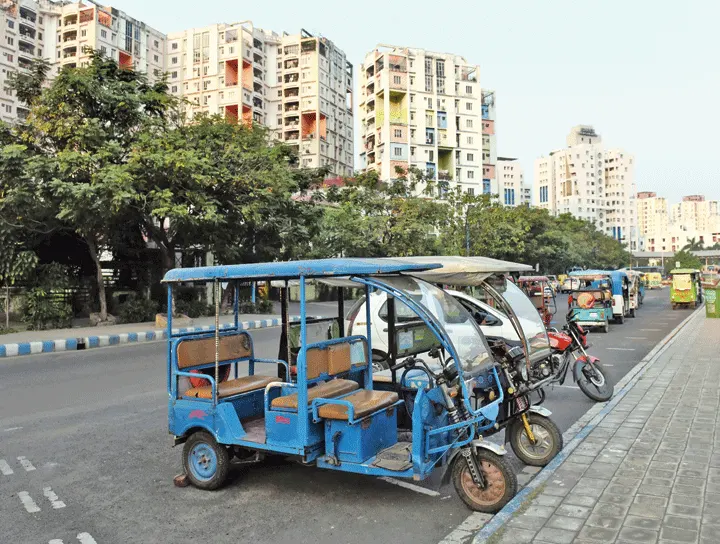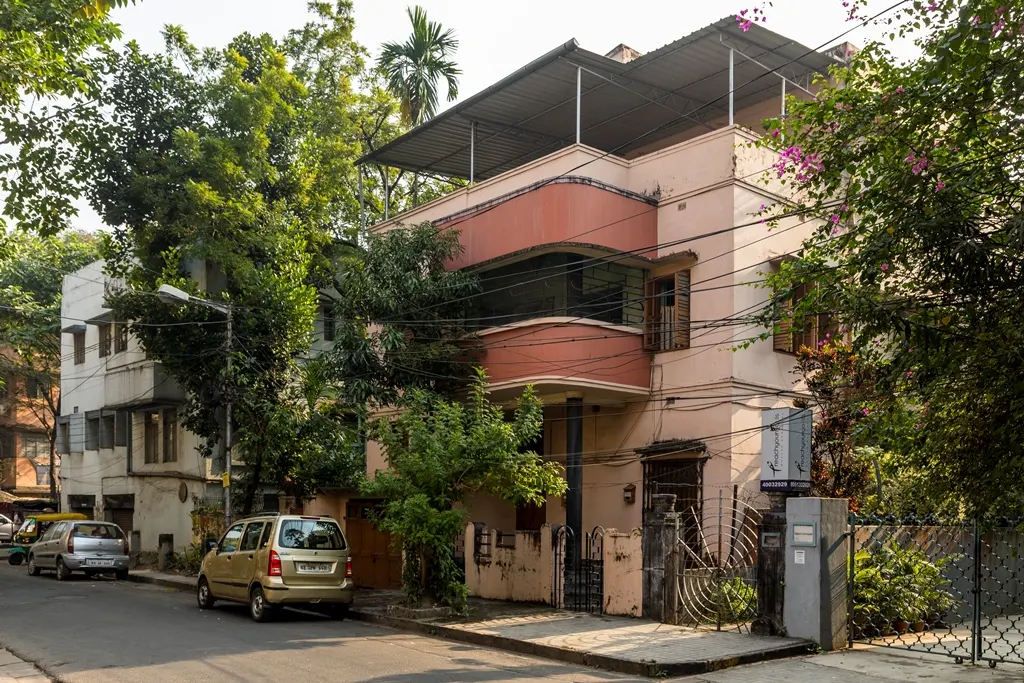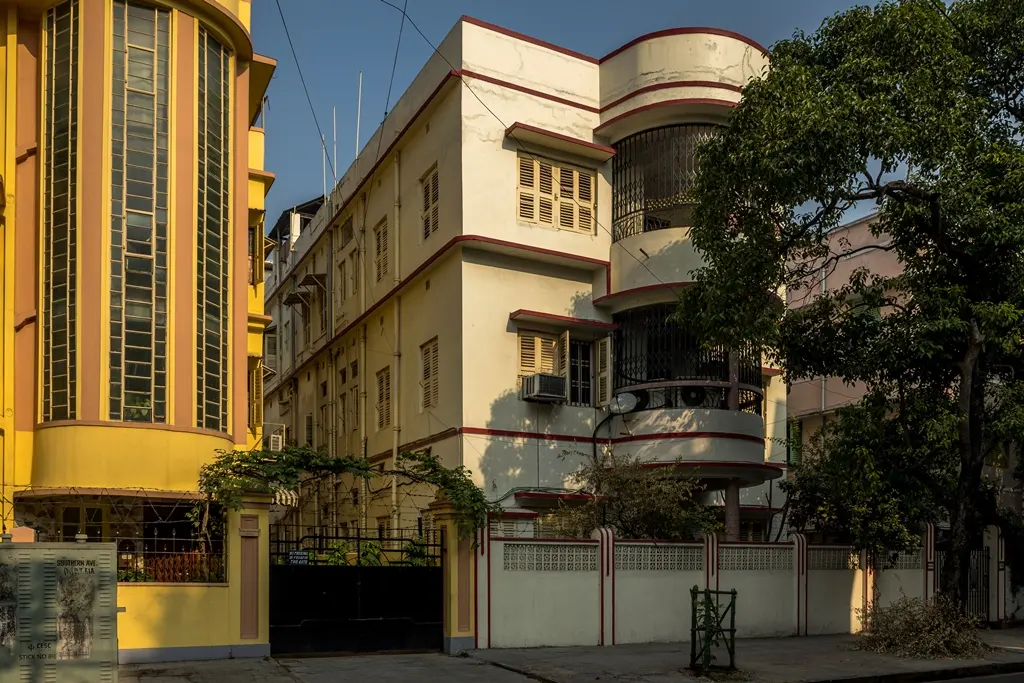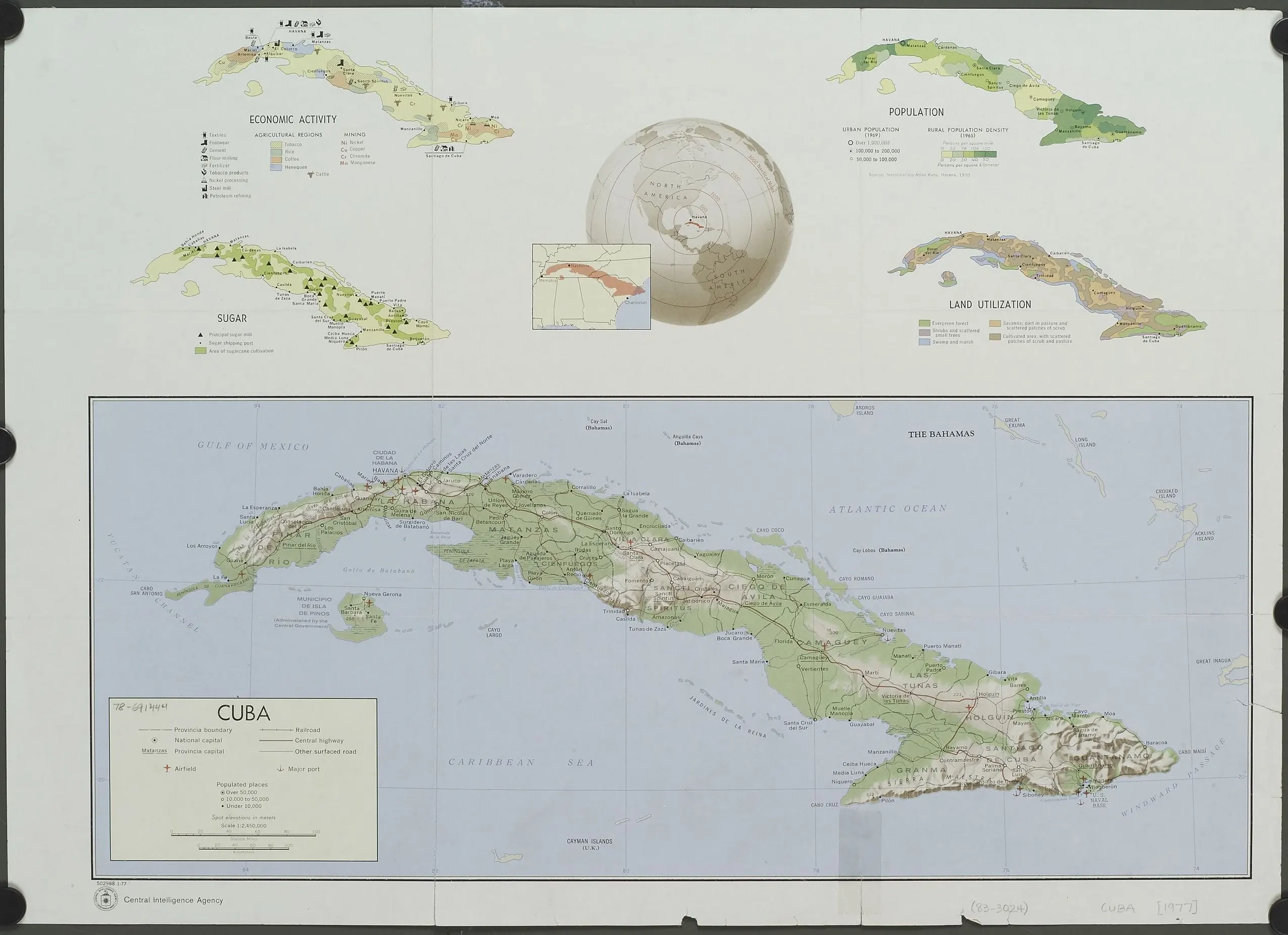The modernity and urbanity of Kolkata—second city of Empire, failed industrial hub of the postcolonial nation—located itself in steel and electricity, coal and steam, ports and bridges. The rickshaw is a relic of this aspirational and colonial infrastructure.
The rickshaw was brought to India in 1880. Men hefted the bulky iron frame onto their shoulders to transport passengers across the streets of Kolkata, moving slowly even as they ran beside horse-drawn carriages. The rickshaw was once normalized and invisible, but now it is a subject of history: in cinemas, calendars, hoardings, ministry brochures, museums and amateur photographs.
The rickshaw is an emblem of Kolkata. Every few years, a moral outrage threatens to relegate the fragile vehicle to the scrap yard—did it not represent indentured labour under the Raj?
The reformed rickshaw—a three-wheeled cycle attached to a two-seater—has replaced most of the hand-pulled rickshaws across the city. More recent reforms are ‘greener’ and ‘smarter’ tuk-tuks or e-rickshaws, all fibreglass and battery-powered, strengthened to ply pockmarked streets. These have been gradually installed in rich residential areas or in potential ‘smart cities’—areas that have been modernized through ubiquitous technological installations, all geared towards the collection of data and its optimization. Kasba and Rajarhat, once populated by labourers from Tangra’s tanneries and working-class farmers of Sonarpur, is now home to a flailing logistics/IT sector. With the e-rickshaw and the tuk-tuk, this informal, union-led, unorganized labour sector has entered the automobile market.
Each rickshawwallah is now a driver with their own unique biometric identification. But the rickshaws are expensive and the batteries require yearly replacement; most manual rickshaw workers cannot afford such an investment. With this excuse, ride-sharing apps like Ola and Uber have been acting as third-party suppliers of vehicles, leasing them to drivers on the condition that monthly payments are made. The old communist vanguard wanted to phase out the vehicle but the current Trinamool Congress never promised the same. As plans for development become election promises, only some manual rickshaws are replaced for e-rickshaws, producing a technological transformation so piecemeal it appears as ornamentation.
Elsewhere, the rickshaw returns to the trappings of an object. An acrylic painted skeletal form adorns the exterior of a gallery and studio in Hindustan Park, right next to a quaint café. The café, too, boasts of artistry and the beauty of accidental heirlooms—its interiors are cobbled together with odds and ends to achieve curated asymmetry. Rusted pipes, old turquoise mosaic tiles as tables, small mirrors and scarves, coloured sockets, each square inch a frame. Next to each other, the two buildings signal towards kitsch, and through that mingling, fragments of a history and legacy.
I always meet my friends at these cafes, my friends, all of whom belong to the arts and the academy, who remind me that the coffee is good here. When one such café is teeming with people, we walk for a minute and find another just like it—a café retaining the structure of the house that came before it, hollowed out of its inhabitants and filled with dimming light, its green venetian windows part of the decor. Seated, we see others just like us—students, early career researchers, old professors and teachers, publishers, the upwardly mobile office-going crowd. The longer you spend in a city, the easier it is to recognize the contours and shape of a class in a single individual. We wonder why the old return to this city to settle down, we pontificate about the allure of the language and the transport. ‘What is it about Kolkata that every inhabitant claims a stake in this cultural and regional pride?’

Sometimes, we eavesdrop, and something of this practiced regionalism creeps into our gossip. We point and say: these people are the business class, these are the non-Bengalis. We point at the handpicked books and say, wouldn’t our friends love to read this?
The Gentrification of Heritage: Calcutta Architectural Legacies Project
Since 2016, the citizen-led initiative, the Calcutta Architectural Legacies Project (CAL) has aimed to protect and preserve a particular artifact: the old residential houses of the eighteenth and nineteenth century—constructed by ‘anonymous builders and masons’—just as Calcutta gazed upon the allure of modern cosmopolitanism. The houses lining the streets of Bakulbagan, Hindustan Park, Kidderpore, Paddapukur, Bhowanipore, Ballygunj and others present a unique legacy and heritage, a ‘jumble’ and a ‘jugaad’ of architectural styles instead of a discernible characteristic1. Unlike other public work initiatives, like the People’s United for Better Living In Calcutta (PUBLIC) or Kolkata Environment Improvement Project (KEIP), the CAL has focused on art and architecture and held court in influential venues2.
Officially, the protection and preservation of heritage sites depends upon mandated state and central governmental bodies. A plot of land containing a town, a monument old enough to confer religious significance, a place of birth and death, or an object of historical or social weight can be classified within three tiers of priority and then verified. In the state, the West Bengal Heritage Commission can verify claims or classify cultural artifacts as heritage, pass laws to protect it from sale, redevelopment or vandalism and even nominate it to be classified as a UNESCO World Heritage site, conferring further protective measures.
Bengal also has a host of other museums and libraries, most of them established as part of the colonial civilizing mission which have their own, fraught, curatorial practices3. On a national scale, the Bharatiya Janta Party (BJP), a right-wing conservative government in power for the last eight years, have spearheaded the Heritage City Development and Augmentation Yojana (HRIDAY) in 2015, bringing twelve cities into its fold to celebrate their particular religious and cultural import. These projects arrive on the heels of the UNESCO recommendation to preserve Historic Urban Landscapes in 2011.
Alongside these projects, CAL demands legislative reform to reclassify the heritage of the city itself, framing the view of the street (viewed from the ground) as a unique aesthetic experience—much like the High Streets Heritage Action Zones in London or the Berlin Modernism Housing Estates.
The most plausible reason for CAL’s small modicum of success can be ascribed to the description of a particular antagonist: the real estate market. CAL reports that the real estate market has been bulldozing these heritage houses of the city for larger housing projects or town planning, sometimes with the consent of the ignorant owner, and sometimes coercively with the help of local party officials. CAL suggests that properties sold to real estate agents be exchanged through a transfer of property rights, transforming land value to architectural value. New homes, hotels, cafes, stores, and even gyms could then be established within the pre-existing structure once it has been sold. The boutique stores and cafes I describe lining Hindustan Park have changed hands in this manner—although many similar properties are currently being delisted and auctioned off to the highest bidder. The success I mention is relative and contextual.

But history is fickle in the hands of a country; success is always relative, prelude to a riot, swaying like a flag4. Once history has been claimed, it can be demolished; once law changes hands (as it so often does), another past can be revived, a temple built, a power wielded. What permanence and protection can ‘heritage’ claim after the demolition of Babri Masjid on 6 December, 1992? What does law and legislative reform count for when the construction of a Ram temple can begin during a pandemic (in August 2020) built over the same site that was systematically razed?
In his essay, ‘The Cult of Monuments’, Alois Reigl states that all cultural artifacts are identified and cared for on the basis of three distinctive memory values: a commemorative value, a historic value or an age value, although these values are often derived in combination or exclusion5. Commemorative value is deliberate and functional; the artifact working as a mnemonic device, such as a memorial site or tomb. Historic value represents something fundamental in the development of the human, and the artifact demands perpetuity and timelessness. Age value, however, is the delight in ruins: in change and material dissolution. In this frame, cultural artifacts like the aforementioned residences of Calcutta represent humanistic development whose conservation confers a historic value upon their material fabric(s). This is the history of the bhadralok within an urban cosmopolitanism, the dream of internationalism instead of the globalization we have been saddled with.
But memory is a ghost, a spectre, an abstraction. As art, architecture conspires with memory. The heart of the CAL project is neither art nor architecture but home. The home is peopled, roomed, ‘in the shape of a life grown old’6. The memory may be singular, but the home never remains static or uniform. The citizen in the shade of this conservationist project is the propertied, the homeowner. Each monumental memory holds renovation and dispossession. In the writings of Amit Chaudhuri—the mascot of the CAL project—Reigl’s age value is distinctly idealized, and his dismay about ‘gentrification and boutiquification’ appears to privilege a less interventional conservational practice, akin to how one would treat the maintenance of a loved home.
Moreover, age value is pronounced in Chaudhuri’s idea of modernity, an age already past. This modernity is aestheticized, explained as ‘born with the aura of inherited decay and life’7. Elsewhere, he claims that ‘urban dereliction can be beautiful’8. This is the modernity that Partha Chatterjee will call ‘ours’ as an ambiguous response to the colonial project9. The CAL project desires to remember it, hopefully without nostalgia.
This is different from the historic value sought by the large-scale project of HRIDAY. These sites belong entirely to the past, painted a specific saffron, dotted across the country in many smaller ancient cities like Varanasi or Ayodhya. Varanasi, for example, is a city revered as the locus of many Hindu myths; its ghats on the river Ganga, in particular, are a pilgrimage site and a ritual cremation ground. In 2014 and 2019, Prime Minister Narendra Modi campaigned (and won) his parliamentary seat from the banks of Varanasi. HRIDAY too is concerned with modernity, albeit one where history is made mappable, accessible, even mutable. Here, the guarantee of a networked Brahminical Hindu tradition hopes to make urban migration a pilgrimage10.
Despite varying conceptions of modernity, the citizen’s institution and the national(ist) project go through the same processes, the same courts of legality and the same markets of the iconic/exotic, as they move from one local listing to an international one. In the manner in which it exists, heritage only obscures its fetishistic character. CAL’s attempt to revive the urban through the moral imperative of law will always produce gentrification, the congealing of a history into a flavour or character, producing a modernity that fits into the embedded and simultaneously exhibited.

Urban Planning via Techno-capitalism
The post-Independence Kolkata city has never attained the same fervent activity it did under the British. Some blame it on lack of colonial resources, some mourn the partition, some bemoan the flight of capital after the Naxalbari riots, some claim that the Bengali bhadralok (much less the working man) is inherently incapable of collecting rents or doing ‘business’, some claim deindustrialization or fragmented proletarization and underdevelopment, some still say that the central government has crippled it with debt. The city throngs with a sense of injustice so double-edged it becomes cinematic: streets named after the auteurs of social realism, walls thick with blazoning bills against capitalism. Origins are doubted: did the thirty-year-long communist government capitalize on this sense of victimization or did it produce it, with our contemporary still carrying the stench?
The city continues, metro line stretching into the semi-urban through demolition—inhabitants promised relocation/inadequate compensations—for the flashier development of profitable enterprises. Along the stretching eight-lane Eastern Metropolitan Bypass, several starred hotels build floating swimming pools and restaurants, while above it extends the 9.2 kilometre long Maa flyover (opened up in 2019) and the proposed stanchions of the Chingrighata flyover, bypassing environmental concerns about damaging the ecosystem like it had in the 1980s to build Salt Lake City. Land grabs in the present economy derive legitimacy from colonial laws that destroyed the wetlands—the ‘organic’ classified as the ‘public’ or ‘government owned.’ Ecological crisis is regarded as opportunity.
Despite Kolkata’s chief minister, Mamata Banerjee, championing a ‘greener’ city, efforts have moved in a singular fashion towards technological and financial transformation. Locales like Kasba, Ballygunj, Rashbehari Road, Tollygunj, and Hindustan Parkare are outfitted with fibre optic cables—CCTVs and drone technology gaze upon the debris of residential skyscrapers, and rampant investment and freedom has been accorded to logistical companies (data mining and analytics, fintech, blockchain),cybersecurity and cybernetic development (facial tech, e-governance, etc.).
Smart city development and e-governance measures tend to materialize slowly and unevenly across high density areas of interconnection, lacking the necessary infrastructural stability to build on disparate topologies11. Outfitting with ubiquitous tech or the Internet of Things (IoT) makes a city unable to shift and adapt over time or space, producing dissimilitude and dissonance, warranting (corporate) mediation.
When a city is established over the old co-operative or public land, everything becomes privatized. The tenders of roads and rails float on the internet only to enable the supply chains of e-commerce—enabled by the situational information produced within a smart city—as informal labour and the local kirana store become obsolete. The embedding of technologies in the smart city begins to make the spaces visible to the structures of control, whether social or technical, while producing a growing surveillance industry12.
A smart city is likely to capture and collect on pre-existing infrastructure as well as pre-existing epistemes. As the city renders itself visible on remote sensing and spatial technologies, the by-lanes grow narrower and busier. The old can seamlessly meld into the new in already connected areas, even in the old residential areas, traversable only by pedestrians and smaller vehicles.
Follow the rickshaw outside Howrah and the ports, where children of the peripheries blacken their lungs on the lithium of dead batteries deposited on electronic waste piles. Follow the rickshaw, from the raided union to the co-opted union, from mobility to iconicity, from the environmental concern to the technological development, and you will find the character of a city petrified against a homely wall.
Six years ago, a friend and I walked through the streets of South Kolkata, exploring a neighbourhood I had just moved into. We walked up to sleepy shop-owners and peered through gates, asking for directions like it were a field exercise in intellectual rigour.
‘What street are we on?’ he would say, and I would follow that up with a perplexing, ‘How far does it go?’
In a derelict park overlooking three old houses, we collated our findings. There were many discrepancies: our memory of the street did not match the address painted on shop fronts or embossed on nameplates of new houses. The distance between one street and another was longer Google maps than the quick ‘take-a-left’ explanations from the locals we encountered. There were new structures where streets were supposed to end and dead-ends at bus-stops. We stopped once we were tired, convinced that we did not know where the truth began or where it was imposed by force, giving ourselves over to a rickshawwallah to take us home.
The Calcutta Architectural Legacies project seemed to creep alongside us, claiming this slatted window and that circular verandah as part of a protected culture, a visual archive. Old bare-bodied men peered out to remind us of generations of propertied wealth, porches decorated with plants threatening the footpath. But the city was new, too, crowded and teeming, full of poor migrants from Bihar, Jharkhand, the Northeast, even Nepal or Tibet, speaking a language they were yet to entirely learn. Some slept under bridges and set up stalls on the footpaths as they waited and jostled for citizenship. While setting up the apartment, I watched an old municipal worker set up a home across the street, complete with a mattress and a mosquito net on the porch of an old residence built in the nineteenth century. Now, drones and surveillance cameras begin to take over the airspace, anti-homeless infrastructure covers the land, especially after whispers of bad hygiene and poverty threaten upperclass demographics. The parks and public infrastructure that were once meant for loitering become gated and ticketed, sites of cultural influence or heritage.
I don’t know how to mourn a city that I never saw, the city that Calcutta Architectural Legacies wishes to protect through legislative reform, regulations and ticket prices. But I do know space is privatized with every building that becomes listed for protection. There’s no reason for this to happen. In large parts of Europe, the Alternative Spaces Movement was rooted in the idea of the commons, squatting and informal housing, housing rights, where the home is a ‘site of cooperation, emancipation, and self-organization.’
But the heritage project tends towards reform, towards politics, towards investment and development and all that comes murkily dragged through the newly-fitted pipes. Insofar as it compromises towards preservation, law, colonial and bourgeois legacy, globalization and the very capital it antagonizes—it eschews the radical potential of what inspired it. It gives up on a robust social landscape of housing rights and a freedom of movement to replace it with a building; it gives up on the land we know for the icons we strain to remember.
Urbanization is a never-ending process, and we continue, variations on the city’s history calcifying into listed properties. We hang frames on all the walls. We gasp in transgressive pleasure at the artistry of it all.

